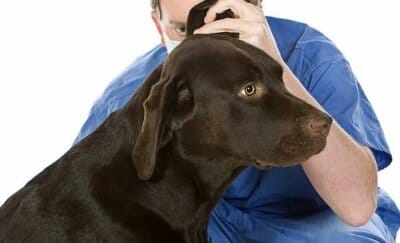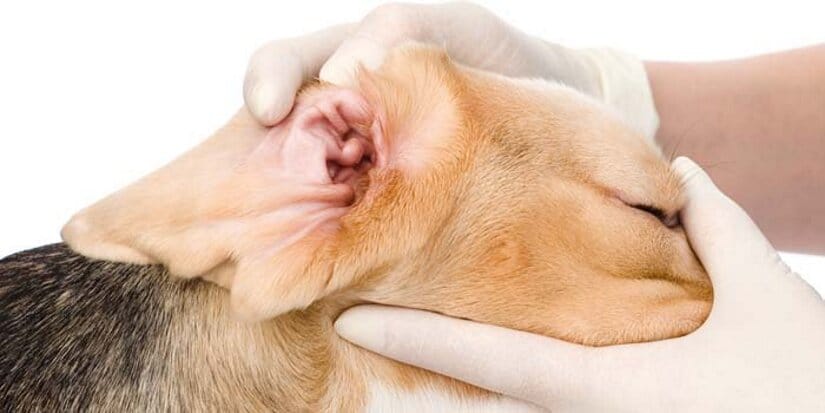Have you ever wondered why it’s sometimes hard to pick up signs of an ear infection in your dog right away? Your dog might still be running around playing Frisbee, but if ear infections are not treated right away they can become serious and very painful. You don’t need to be a veterinarian to pick up signs of an ear infection, but the more you learn about what causes them and how to treat them, the better a pet parent you’ll be.
Why Do Ear Infections Occur in Dogs?
All dog’s ears have bacteria and yeast inside of them. Both of these should be in the appropriate amount, but when either the yeast or bacteria get out of hand, you’ll end up with an ear infection in your dog.
Most dogs tend to get ear infections and injuries in the outer ear from dirt or foreign objects. These can be easily seen by the naked eye, and is called otitis externa. Although very common in all dogs, it can be very painful.
Outer ear infections are caused by too much moistness inside the ear, bacteria, mites or small bugs, and even skin allergies that your pooch may be prone too. Some dogs get ear infections because they are prone to them. Others will get them because of skin infections or trauma. Dogs that are also not that healthy with a weak immune system may be prone to ear infections as well.
Symptoms of an Ear Infection

These could be as minimal as a few head shakes, walking with his head tilted sideways for a second or two, and slight pawing of the ear and area nearby. When it comes to being mindful about your dog’s health, this is one of those times since ear infections tend to become more serious in a short span of time. It’s a no-brainer, if in doubt take your furry best friend straight to your veterinarian for a quick consult. With that said, you’ll be sure to know whether Fido has an ear infection.
Watch out for These Signs:
- Fido tilting his head to one side
- Scratching or pawing of one or both ears
- Foul odor emanating from the ear
- Redness or pain from the inside of the ear flap or ear opening to the ear canal. You’ll notice him flinching away if you try to lift his ear. He may also snap or growl because of the pain. This is not at you, but just because he feels really sore and does not want to be touched. Consult with your emergency veterinarian right away if it’s after hours, so that you can get pain relief for your pooch. In that way he can get treated right away, instead of waiting until the next morning. Helping to treat your dog’s pain immediately and effectively, by consulting with your veterinarian as soon as you notice signs of an infection, is part of being a good pet parent
- Temporary hearing loss. Often times you’ll not notice this since the ear infection will only affect one ear, and your dog will respond to you when called, although he may do so slowly since he feels a lot of ear pain.
- Depression or lethargy
- Swollen ear flap
- Lots of circling to either side
- Discharge from the ear in the form of yellow, brown, or even black discharge
Breeds That Are Most Prone to Ear Infections
- Cocker Spaniels
- English Springer Spaniels
- Chinese Shar-Pei
- Basset Hounds
Breeds that have a lot of hair like Poodles, Sheepdogs and Schnauzers are also prone to ear infections. Dogs that enjoy spending time in the water are also prone to swimmer’s ear which is caused by moisture being trapped within the ear canal. Dogs that have upright or pricked ears tend to have fewer ear infections since their ears have a chance of “drying out”. Dogs that have been ill, or whose immunity is faulty can also come down with ear infections more easily than healthier dogs.
Ear infections have also been linked to food allergies, as can be the case with chronic ear problems. The only way to treat these is to diagnose the food allergy. Skin diseases in dogs can also cause an ear infection.
How Does Your Veterinarian Diagnose and Treat Ear Infections?

Your veterinarian will diagnose Fido’s ear infection by looking into his ear with an otoscope. This enables him to see deep inside the ear where he will be able to check for mites, foreign bodies, inflammation, and other conditions. If there is something in your dog’s ear, he will then remove it with alligator forceps. He will also take some samples of any discharge that will be sent to a lab to check for bacteria, parasites or yeast.
Veterinarians will also suggest that you trim the excess hair inside your dog’s ear. Although many groomers recommend plucking your dog’s ear hair, veterinarians suggest that this may contribute to inflammation, which in turn may cause infection. Your veterinarian will prescribe a topical antibacterial or antifungal medication. If there are mites inside your dog’s ear, then a different medication is prescribed for getting rid of them.
How to Apply Ear Medications Inside Your Dog’s Ear?
- Hold Fido’s head with one hand with the ear flap lifted upwards.
- Quickly squeeze the ear ointment into the ear.
- Massage the cartilage at the bottom of the ear, so that the ointment flows down into the ear canal.
- By doing the above step, when your dog shakes his head, the medication cannot fly out.
- Continue with the ear medication for the full duration of treatment recommended. If you don’t finish the full course of treatment, chances are that the ear infection will come back again.
- Visit your veterinarian for a follow-up exam within 7 days of completing treatment.
- Your veterinarian will prescribe oral antibiotics if the initial treatment has not been successful.
Tips for Preventing Ear Infections
- Examine Fido’s ears every week.
- Clean your dog’s ears with a cleansing solution that is best recommended by your veterinarian.
- Never use alcohol for ear infections. This can cause inflammation. Consult with your veterinarian for advice.
- Trim your dog’s excess ear hair every couple of months.
- Use a drying agent if your dog is prone to swimmer’s ear in warm weather after swimming.
- Keep up with flea and tick meds.
- If Fido’s ear infections are of the chronic type, follow your veterinarian’s care tips.

Fortunately, there’s much that can be done to ease ear infection pain with newer treatments, as well as holistic options for preventative care. Make every effort to prevent an ear infection from occurring in the first place. Read your dog’s body language and non-verbal cues daily, so as to assess how he’s feeling. Simple signs like a head shake or tilt could indicate the beginnings of an ear infection. Discuss preventative care with your veterinarian if your pooch is prone to ear infections. A healthy dog is a happy one!

It was really helpful when you said that a sign can be discharge coming from their ear. Last night I noticed some discharge coming out from my dog’s ear, and I was wondering if that was a bad sign. I’ll have to look into finding a vet to take her to, to see if she has an infection.